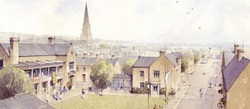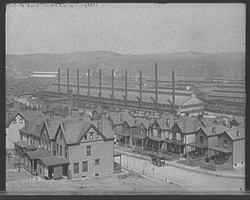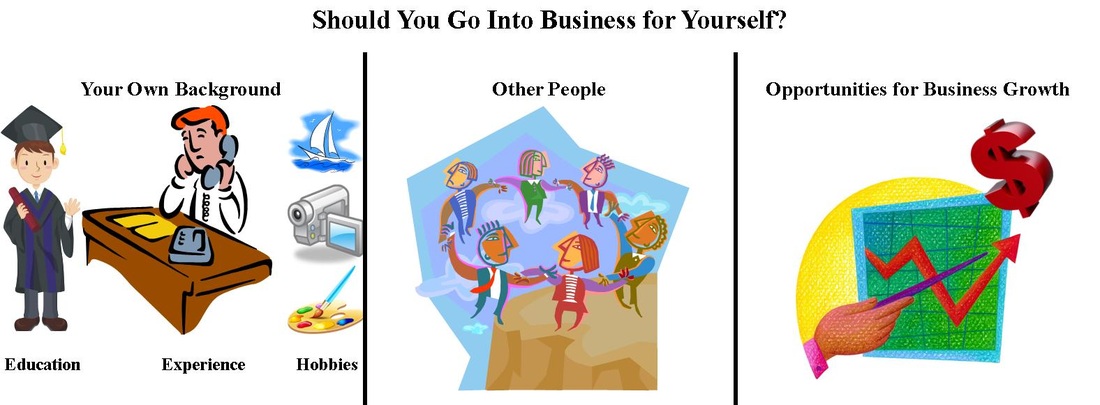The illustration above is based on one that appeared in a U.S. government publication. Its purpose was to help people who were thinking of starting their own business.
Study the illustration. Be able to explain the meaning of each of the three parts of the illustration.
Part 1 - Blog Response - In your response you need to answer the following questions:
1. What does your background have to do with your selection of a business to start?
2. Why are the following factors included under a person's background: (a) education, (b) experience, and (c) hobbies?
3. Why should other people affect a person's choice of business?
4. What is meant by "opportunities for business growth"? How should this factor influence a person's choice of business?
5. Based on the illustration, if you were going to start your own business what kind of business would your start and why? Be sure to refer to the illustration in your response.
Part 2 - Classmate Response - Respond to one (1) classmates' response.
I. Activating Prior Knowledge
Adam Smith, a Scottish economist and moral philosopher, was the author of a book entitled, An Inquiry into the Nature and Causes of the Wealth of Nations more commonly known as The Wealth of Nations. This book revolutionized the understanding of economics. In this book, Smith stated that the free-market economy is more productive and beneficial as it related to division of labor, span of markets for raw and manufactured goods, use of money, and valuing commodities. He stated:
"The real price of every thing," says Adam Smith,[3] "What every thing really costs to the man who wants to acquire it, is the toil and trouble of acquiring it. What every thing is really worth to the man who has acquired it, and who wants to dispose of it, or exchange it for something else, is the toil and trouble which it can save to himself, and which it can impose upon other people. That this is really the foundation of the exchangeable value of all things, excepting those which cannot be increased by human industry, is a doctrine of the utmost importance in political economy."[4] In the excerpts that follow, we will look at how the introduction of the potato to Europe and the changes it brought about in agricultural production impacted the Industrial Revolution.
II. Setting A Purpose for Reading
According to Smith, how would the introduction and use of the potato revolutionize European crop production?
III. Reading the Text (Read, Re-read, and Read Again)Adam Smith – The Wealth of NationsThe vegetable food of the original inhabitants of the Americas, though from their want of industry not very abundant, was not altogether so scanty. It consisted in corn, yams, potatoes, bananas, tomatoes, etc., plants which were then altogether unknown in Europe, and which have never since been very much esteemed in it, or supposed to yield a sustenance equal to what is drawn from the common sorts of grain and pulse, which have been cultivated in this part of the world time out of mind. Stop! Can you answer these questions? If not, go back and re-read the passage. How did colonialism and the Columbian Exchange benefit Europe?
The food produced by a field of potatoes is not inferior in quantity to that produced by a field of rice, and much superior to what is produced by a field of wheat. Twelve thousand weight of potatoes from an acre of land is not a greater produce than two thousand weight of wheat. The food or solid nourishment, indeed, which can be drawn from each of those two plants, is not altogether in proportion to their weight, on account of the watery nature of potatoes. Allowing, however, half the weight of this root to go to water, a very large allowance, such an acre of potatoes will still produce six thousand weight of solid nourishment, three times the quantity produced by the acre of wheat. An acre of potatoes is cultivated with less expense than an acre of wheat; the fallow, which generally precedes the sowing of wheat, more than compensating the hoeing and other extraordinary culture which is always given to potatoes. Stop! Can you answer these questions? If not, go back and re-read the passage. What were the benefits of growing potatoes?
Should this root ever become in any part of Europe, like rice in some rice countries, the common and favorite vegetable food of the people, so as to occupy the same proportion of the lands in tillage which wheat and other sorts of grain for human food do at present, the same quantity of cultivated land would maintain a much greater number of people, and the laborers being generally fed with potatoes, a greater surplus would remain after replacing all the stock and maintaining all the labor employed in cultivation. A greater share of this surplus, too, would belong to the landlord. Population would increase, and rents would rise much beyond what they are at present. Source: Internet History Sourcebooks - http://www.fordham.edu/halsall/mod/1695potato.asp Stop! Can you answer these questions? If not, go back and re-read the passage. How would the growing of potatoes benefit the people and economies of Europe?
IV. Personal Reflection - Respond to the following questions in your blog. Be sure to include quotes from the text to support your response. Part 1 Response - Explain the following statements in terms of supply, demand, and division of labor – “A greater share of this surplus, too, would belong to the landlord. Population would increase, and rents would rise much beyond what they are at present.” Part 2 Response – If a farmer decided to raise ONLY potatoes, what would be the advantages and disadvantage of this decision? What would happen if a disease killed the majority of the plants, similar to the Irish Potato Famine of the 1800’s? How would you and your family deal with the crisis? V. Peer Reflection – Read three classmates’ reflections and respond to what they have written.
 An English Mill Town.
Source: princes-foundation.org
 An American Mill Town.
Source: levinemuseumofthenewsouth.blogspot.com
I. Activating Prior KnowledgeCharles Dickens was a writer during the Industrial Revolution. As a young man, Dickens was forced to leave school and take a job in a factory when his father was thrown into debtor’s prison. Many of his works served as social commentary on the state of England and English laws during this period of time. His characters and their stories reflected the struggle between the wealthy and the industrial poor striving to make a living in the harsh, unforgiving conditions. Whether it was a miserly business man who comes to see the error of his ways ( A Christmas Carol), a young boy living a miserable existence forced into a life of crime ( Oliver Twist), or a young man forced by an abusive step-father to work in a factory ( David Copperfield), we see the impact that a significant and rapid change from an agricultural existence to an industrial existence had on the people of the era. While the writings are fictitious, their narrative about the state of man at this critical juncture speaks of frightening truths and harsh realities with the added element of satire and humor to make the living bearable. II. Setting A Purpose for ReadingCoketown cannot be found on a map and only existed in the imagination of Charles Dickens. However, the images of life in industrialized England create a collage that becomes Coketown. As you read the excerpt from Dickens’ Hard Times, look carefully at how he describes the features of Coketown. Create a mental picture of what you think Coketown would look like and ask yourself, “Would I like to go there? Would I like to live there?” III. Reading the Text (Read, Re-read, and Read Again)HARD TIMES Charles Dickens Excerpt Describing Coketown, from Chapter 5: THE KEY-NOTE ... Let us strike the key-note, Coketown, before pursuing our tune. It was a town of red brick, or of brick that would have been red if the smoke and ashes had allowed it; but as matters stood, it was a town of unnatural red and black like the painted face of a savage. It was a town of machinery and tall chimneys, out of which interminable serpents of smoke trailed themselves for ever and ever, and never got uncoiled. It had a black canal in it, and a river that ran purple with ill-smelling dye, and vast piles of building full of windows where there was a rattling and a trembling all day long, and where the piston of the steam-engine worked monotonously up and down, like the head of an elephant in a state of melancholy madness. Stop! Can you answer these questions? If not, go back and re-read the passage.
From the reading, give an example of imagery (use of words to produce mental
images of specific sensory experiences.)
It contained several large streets all very like one another, and many small streets still more like one another, inhabited by people equally like one another, who all went in and out at the same hours, with the same sound upon the same pavements, to do the same work, and to whom every day was the same as yesterday and to-morrow, and every year the counterpart of the last and the next. Stop! Can you answer these questions? If not, go back and re-read the passage.
How would you describe Dickens’ opinion of Coketown based on the tone
of the passage?
These attributes of Coketown were in the main inseparable from the work by which it was sustained; against them were to be set off, comforts of life which found their way all over the world, and elegancies of life which made, we will not ask how much of the fine lady, who could scarcely bear to hear the place mentioned. The rest of its features were voluntary, and they were these. Stop! Can you answer these questions? If not, go back and re-read the passage. In your opinion, did the wealthy elite live in Coketown?
You saw nothing in Coketown but what was severely workful. If the members of a religious persuasion built a chapel there - as the members of eighteen religious persuasions had done - they made it a pious warehouse of red brick, with sometimes (but this is only in highly ornamental examples) a bell in a birdcage on the top of it. The solitary exception was the New Church; a stuccoed edifice with a square steeple over the door, terminating in four short pinnacles like florid wooden legs. Stop! Can you answer these questions? If not, go back and re-read the passage. What did Dickens mean when he wrote, “You saw nothing in Coketown but what was severely workful.”
All the public inscriptions in the town were painted alike, in severe characters of black and white. The jail might have been the infirmary, the infirmary might have been the jail, the town-hall might have been either, or both, or anything else, for anything that appeared to the contrary in the graces of their construction. Fact, fact, fact, everywhere in the material aspect of the town; fact, fact, fact, everywhere in the immaterial. The M'Choakumchild school was all fact, and the school of design was all fact, and the relations between master and man were ll fact, and everything was fact between the lying-in (birth) hospital and the cemetery (death), and what you couldn't state in figures, or show to be purchaseable in the cheapest market and saleable in the dearest, was not, and never should be, world without end, Amen Stop! Can you answer these questions? If not, go back and re-read the passage. How would you describe the mood Dickens was trying to create in this excerpt?
Source: http://www.uncp.edu/home/rwb/coketown.htmlIV. Personal Reflection - Respond to the following questions in your blog. Be sure to include quotes from the text to support your response.
Part 1 Response – Based on your reading of this passage, how would you describe life in Dickens’ Coketown? Since this piece was in part a social commentary on life in England during the Industrial Revolution, what can conclusions can you draw about what a real-life experience might be like in an English mill town?
Part 2 Response – You have been given to images of life in a mill town. Compare and contrast the English mill town with an American mill town. What generalization(s) can you draw about life in a mill town based on Dickens’ writing and the images?
V. Peer Reflection – Read one classmates’ reflections and respond to what they have written. You may choose to agree or disagree with their response. However, you must give sufficient and supported reasons for your opinion.
|



 RSS Feed
RSS Feed